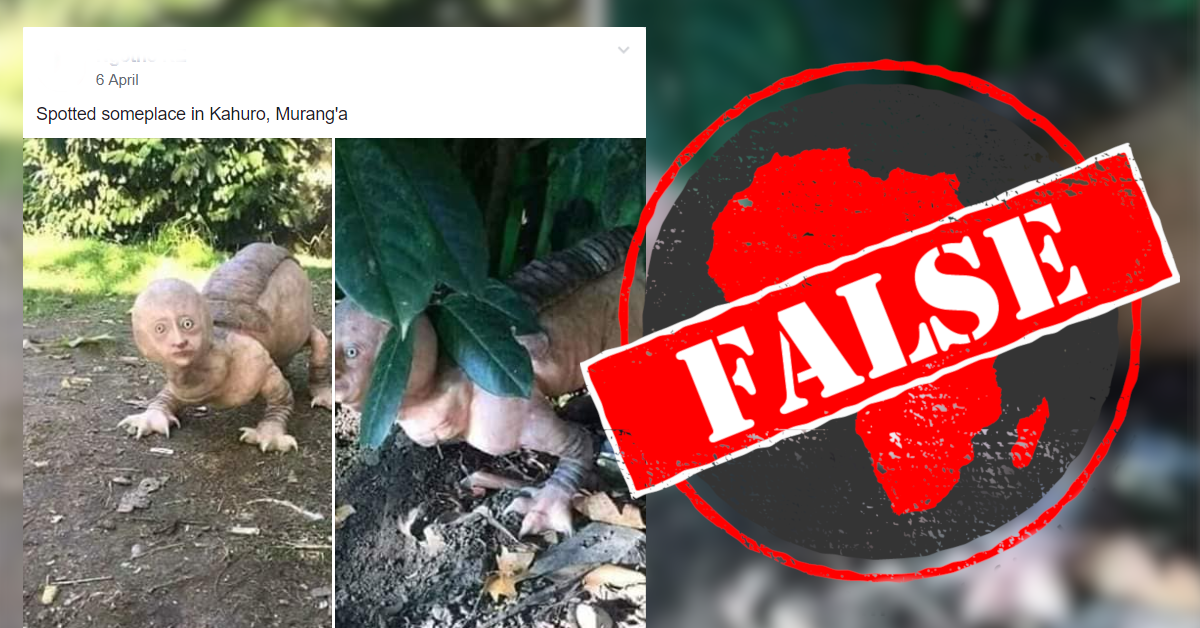Photos of strange creatures have been making the rounds on Facebook in Kenya for some time.
A user recently posted two photos of a four-legged human-faced creature on a Facebook group page with close to 2 million members.
The first photo shows the creature on all fours, claws on bare ground and scales on its back, staring straight into the camera. The second shows it partly hidden behind leafy vegetation.
“Spotted someplace in Kahuro, Murang'a,” the user captioned the photo. Murang’a is a town 75 kilometres northeast of Nairobi, Kenya’s capital.
Since the photos were posted on 6 April 2019 they’ve been shared 350 times and have attracted about 1,400 reactions and 800 comments.
They were also posted on Nigeria’s Nairaland Forum in October 2018, described as “an unknown human-faced creature seen in an erosion site”.
Around the same time a YouTube channel posted a video of the creature saying it was an “animal with human face found in Gujarat Village – India”.

But as Africa Check has found with reports of other strange creatures, the photos aren’t of any living thing.
They show one of the many sculptures crafted out of silicone – a rubbery and lifelike material used to make masks and movie special effects – by Italian artist Laira Maganuco.
Similar sculptures can be seen on her Facebook and Instagram accounts, and her website.
Maganuco describes this particular sculpture as a armadillo-human hybrid. (Other sculptures imagine a pig hybrid and a mouse hybrid.)
A video on her YouTube channel shows that the rubbery silicone makes the sculpture seem to have lifelike movements when shaken off camera.
The sculpture is for sale on creative goods retail site Etsy. Here Maganuco says it was “carved entirely by hand in acetic silicone paste”. – Dancan Bwire (28/05/19)
A user recently posted two photos of a four-legged human-faced creature on a Facebook group page with close to 2 million members.
The first photo shows the creature on all fours, claws on bare ground and scales on its back, staring straight into the camera. The second shows it partly hidden behind leafy vegetation.
“Spotted someplace in Kahuro, Murang'a,” the user captioned the photo. Murang’a is a town 75 kilometres northeast of Nairobi, Kenya’s capital.
Since the photos were posted on 6 April 2019 they’ve been shared 350 times and have attracted about 1,400 reactions and 800 comments.
They were also posted on Nigeria’s Nairaland Forum in October 2018, described as “an unknown human-faced creature seen in an erosion site”.
Around the same time a YouTube channel posted a video of the creature saying it was an “animal with human face found in Gujarat Village – India”.

Made of rubbery and lifelike silicone
But as Africa Check has found with reports of other strange creatures, the photos aren’t of any living thing.
They show one of the many sculptures crafted out of silicone – a rubbery and lifelike material used to make masks and movie special effects – by Italian artist Laira Maganuco.
Similar sculptures can be seen on her Facebook and Instagram accounts, and her website.
Maganuco describes this particular sculpture as a armadillo-human hybrid. (Other sculptures imagine a pig hybrid and a mouse hybrid.)
A video on her YouTube channel shows that the rubbery silicone makes the sculpture seem to have lifelike movements when shaken off camera.
The sculpture is for sale on creative goods retail site Etsy. Here Maganuco says it was “carved entirely by hand in acetic silicone paste”. – Dancan Bwire (28/05/19)
Republish our content for free
For publishers: what to do if your post is rated false
A fact-checker has rated your Facebook or Instagram post as “false”, “altered”, “partly false” or “missing context”. This could have serious consequences. What do you do?
Click on our guide for the steps you should follow.
Publishers guideAfrica Check teams up with Facebook
Africa Check is a partner in Meta's third-party fact-checking programme to help stop the spread of false information on social media.
The content we rate as “false” will be downgraded on Facebook and Instagram. This means fewer people will see it.
You can also help identify false information on Facebook. This guide explains how.


Add new comment